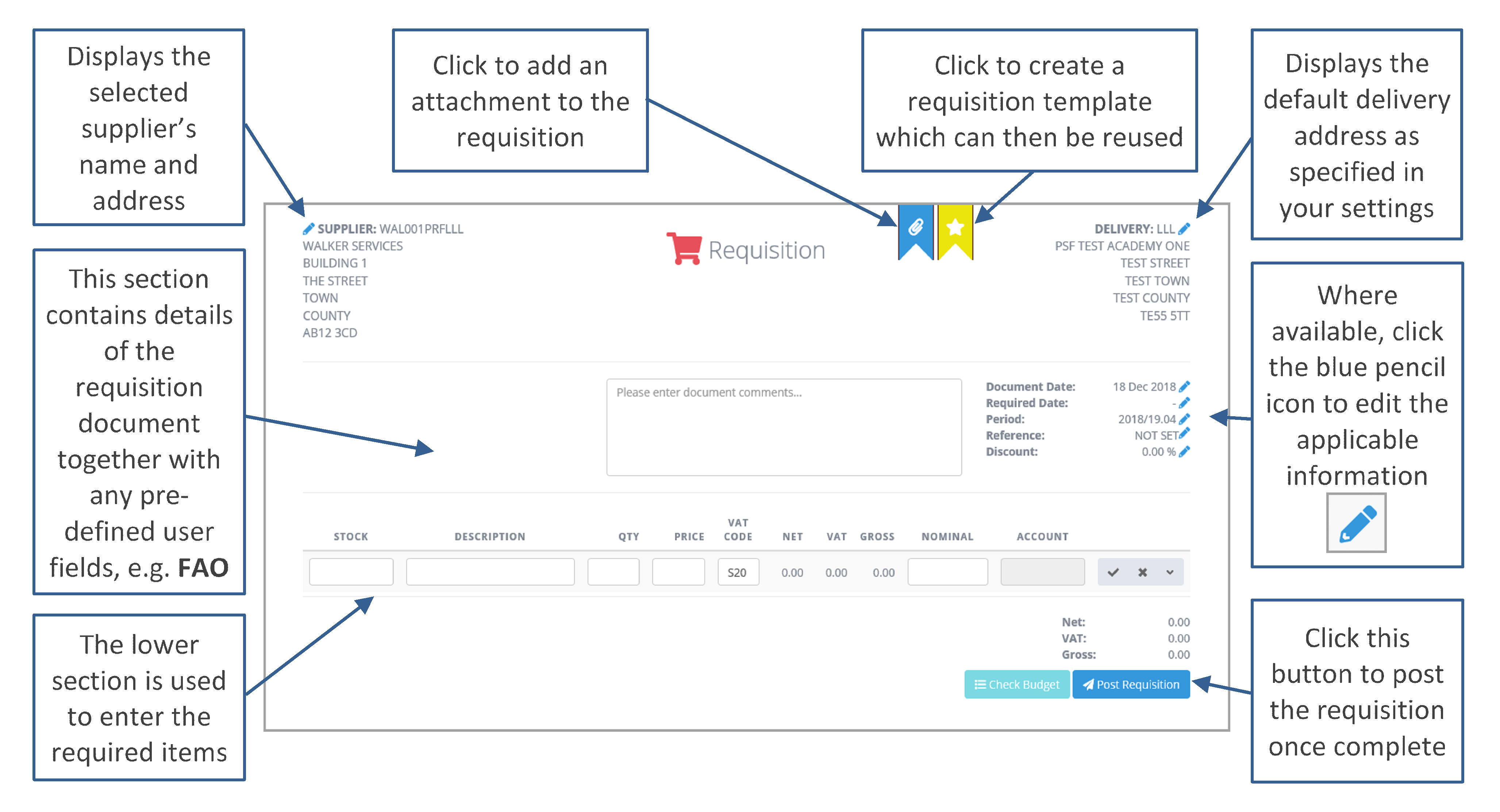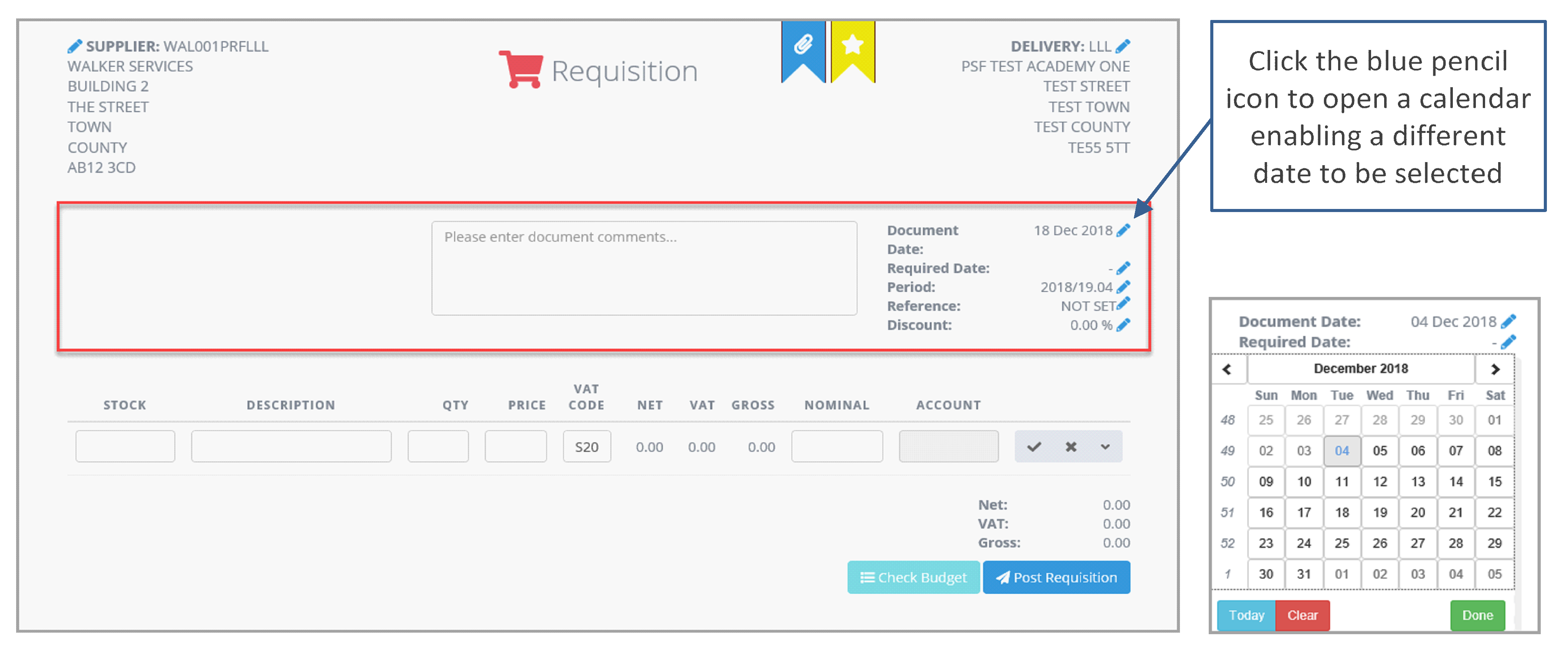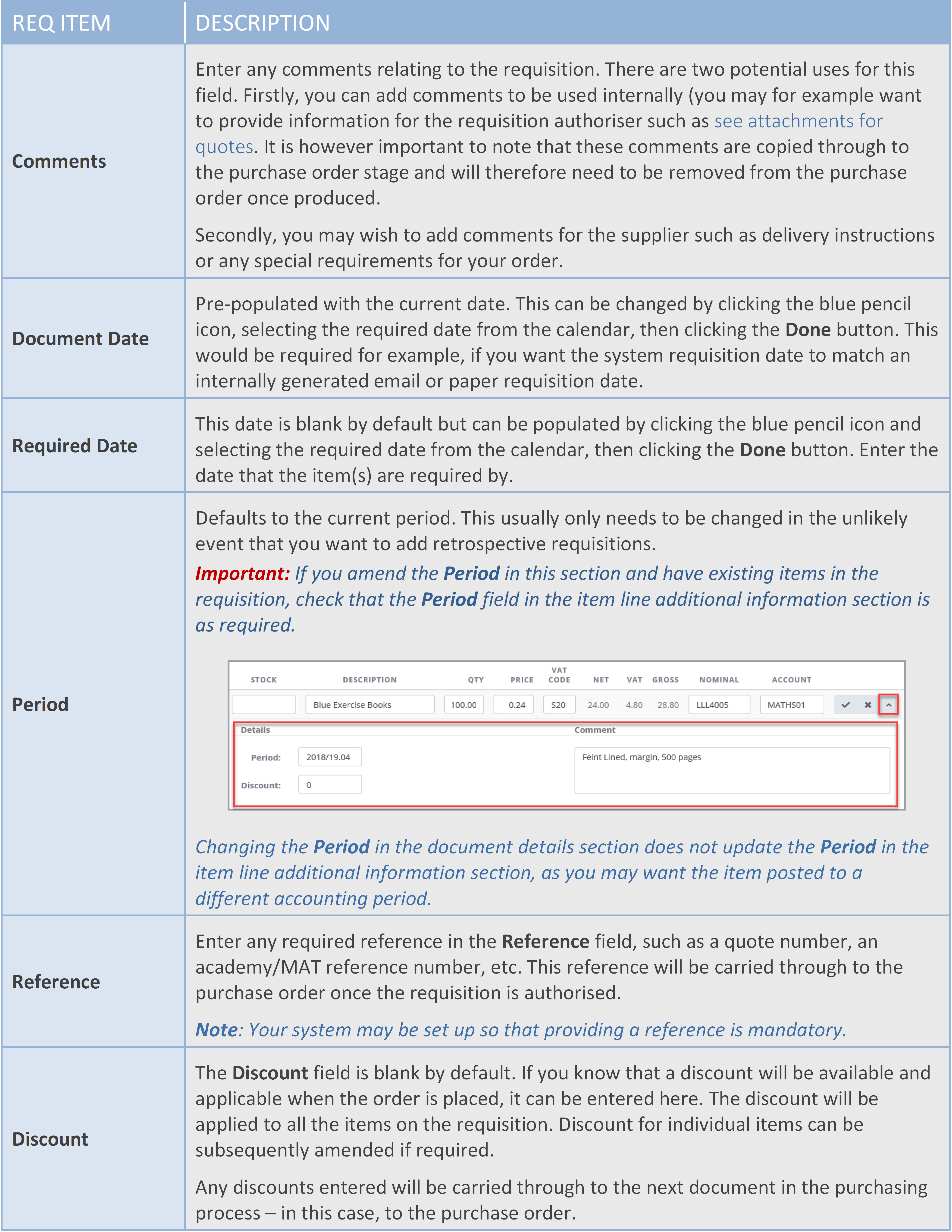Creating a New Requisition
Purchase requisitions are created in IRIS Purchasing to enable members of staff to raise a requisition for authorisation which is then made available to the authoriser for approval. Once authorised, the requisition can then be progressed through the remainder of the purchasing process (purchase order, goods received note and invoice). This process is not required if you use an internal/manual requisition process.
If the Requisition icon or any other settings mentioned in this article are not visible, the System Administrator will need to review the settings as described the User Access article.
Creating a new requisition
- On the IRIS Purchasing Home page, click the Requisition icon.
- A list of suppliers is displayed in the Select your Supplier window.
-
Either scroll through the list, or search for the required supplier via the Search Criteria field at the top. You can enter any element of the supplier's account code or name/title. The list will reduce based on the criteria entered.
The Load Indices check box is selected by default to improve the search performance. It should be left selected. For maximum efficiency, suppliers are loaded 20 at a time. As you scroll through the list, more suppliers will be loaded. A slight delay might be noticeable on slower internet connections.
-
If the supplier is not known at this point, you can click the New button and create a requisition without a supplier. The requisition will then be available for selection via all supplier accounts when being progressed to a purchase order (once the requisition has been authorised).
Your system may be set up so that providing a supplier is mandatory at this stage.
-
Once identified, click the required supplier to select them. The requisition form is populated with the chosen supplier's details (account code, name and address).
Suppliers are added to PS Financials via the PS Accounting module. If the required supplier is not displayed, they will need to be added via PS Accounting by a user with applicable access levels.

Completing the requisition details
The delivery address defaults to the address specified in your personal IRIS Purchasing settings (this can be changed by clicking the Settings icon on the Home page). This will usually be your academy's address.
- If there is no delivery address displayed, or you want to change the delivery address, click the blue pencil icon. To change your default delivery address, please see Setting the Default Delivery Address in IRIS Financials Purchasing. If a new delivery address needs to be created, please see the Adding a New Delivery Address to IRIS Purchasing article.
- From the Select Your Delivery Address window, click the required address to select it.
-
The centre section of the document is used to complete details relating to the requisition itself.

-
Complete/edit the remaining requisition information as follows:

Adding required items to the requisition
Once the document details have been completed you can proceed to enter the items required. The following process should be carried out for each item required:
-
If known, enter the supplier item stock code in the Stock field then press the Tab key to move to the next field.
If a supplier catalogue has been imported into IRIS Purchasing, when you hover over the Stock field, a magnifying glass appears which when clicked, enables a stock code to be selected. This automatically populates the Description and Price fields. For more information, please see the Import Supplier Catalogues topic.
- Enter a Description for the required item, e.g. Blue Exercise Books then press the Tab key to move to the next field.
- Enter the Quantity and unit Price for this item.
- The VAT CODE defaults to the standard rate (this setting can be amended your System Administrator and may be different).
Requisitions and purchase orders are raised exclusive of VAT so this field can be amended during the invoice stage.However, if you know that the item is not vatable or that the rate is wrong, it can be changed here. Hover over the VAT CODE field, click the magnifying glass then click the required VAT code.
- Press the Tab key to move to the next field - the NET, VAT and GROSS are calculated automatically.
- Select the nominal to which the item relates. Hover over the Nominal field, click the magnifying glass then click the required nominal from the Select window.
- Alternatively, enter a relevant word, e.g. book into the Nominal field. The system will display any matching nominals as shown in the following graphic. Select the required nominal from the drop-down list.
-
Choose the cost centre account to which the item should be charged (this can only be done once a nominal has been selected). Hover over the Account field then click the magnifying glass, then click the required cost centre account from the Select window.
A default cost centre account can be set up in the Current User settings tab (accessed by clicking the Settings icon on the Home page) and can subsequently be changed as required. If this setting is not available, please contact your System Administrator.
- Choose a cost centre by entering a relevant word, e.g. Maths into the Account field. The system will display any matching cost centre accounts as shown in the following graphic. Select the required account from the drop-down list.
Adding additional item information
Additional information can be added to each item by clicking the Show Additional Information (down arrow) icon on the far right of the item line.


The fields that are displayed in the additional information section are defined by the System Administrator and may not necessarily be the same as those shown here.
In this example, you can apply a specific Period or Discount to this item by making changes to the applicable fields. You can also add additional information in the Comment field if required.
If you have amended the Period or Document Date in the document details section of the requisition, check that the Period field in the line additional information section is as required.
Changing the Period in the document details section does not update the Period in the additional information section, as you may want the item posted to a different accounting period.:
If you previously entered more than 30 characters in the item Description field, the full description will be displayed in the Comment field.
Validating an item line
- Once you have finished adding the item information, click the Validate icon (tick) to validate the line.

- If the validation fails, an error message is displayed on the top, right-hand corner of the requisition document, and the erroneous field is displayed in red.
- Correct the information and validate again. Further items cannot be added until the item line has been successfully validated.
Adding Additional items
Once an item line has been successfully validated, a new line is automatically created. The total Net, VAT, and Gross for the requisition are automatically updated to reflect the validated items.

The icons to the right of the validated item line can be used to make amendments as follows:
Complete the new item information in the same way as previously described. If the item is similar (for example, yellow exercise books), it can save time to copy the existing line and make minor adjustments as described in the following section.
If delivery charges are known at this stage, they should be added. However, it is best practice to only add them if you have access to the correct nominal/account used to which delivery charges should be applied. Check with the System Administrator if you are in any doubt or leave the delivery charge to be added at the purchase order/invoice stage.
Copying existing items
-
To copy an existing item, click the Copy icon on the right-hand side. A new line will be displayed with the exact same content.
- Make the required amendments.
- Validate the line in the usual way. As before, the Net, VAT and Gross for the requisition are automatically updated to reflect the new item(s).
Viewing or adding attachments
- To add an attachment, click the Attachment icon at the top of the requisition and select the required file(s) from the Choose File to Upload Alternatively, drag the required file(s) from Windows Explorer anywhere onto the requisition.

- Once attached, documents can be viewed by hovering over the Attachment icon at the top of the document, then clicking the required attachment name.
Checking the budget before posting
Depending on how your system has been set up, you may see a Check Budget button at the bottom of the requisition. This functionality is often used by cost centre managers such as heads of department to check the impact of this order on their budget.
If the button is visible, clicking it allows you to see the impact of this purchase on the chosen budget/nominal and whether the item is within budget limits, as shown in the following graphic.
This window may look slightly different if your system has been set up to check a budget at account level. In this case, it will be grouped on account code and there won't be a nominal column.
If the requisition falls within budget, then the information is highlighted in green. If the requisition goes over budget, then the information is highlighted in red. The previous example is highlighted in red simply because no budget has been set up for this cost centre. Click the Back button to return to the requisition.
Posting the requisition
If this requisition is one that you are likely to use again, i.e. the items are to be regularly ordered, you can save this requisition as a template that can be re-used. For more information, please see Creating Document Templates.
Once all the required items have been entered and validated, click the Post Requisition button.
Error messages are displayed if any lines have not been validated or any mandatory data is missing (the affected mandatory fields are then highlighted in the purchase order).
Once the requisition has been successfully posted, a requisition document number is automatically generated, and a success message is displayed in the top right-hand corner of the window. Clicking the message opens a read-only copy of the requisition.
By default, you will be returned to the Home page, but this can be changed via the Current User tab in settings (accessed by clicking the Settings icon on the Home page) so that a read-only version of the posted document is automatically displayed. F
The requisition is now ready for authorisation and once authorised, can be progressed to purchase order. An email will be sent to the person responsible for authorising this requsition.